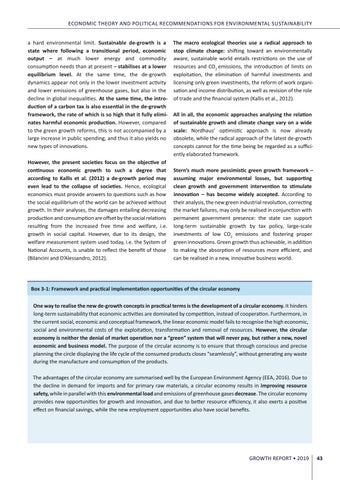ECONOMIC THEORY AND POLITICAL RECOMMENDATIONS FOR ENVIRONMENTAL SUSTAINABILITY a hard environmental limit. Sustainable de-growth is a The macro ecological theories use a radical approach to state where following a transitional period, economic stop climate change: shifting toward an environmentally output – at much lower energy and commodity aware, sustainable world entails restrictions on the use of consumption needs than at present – stabilises at a lower resources and CO2 emissions, the introduction of limits on equilibrium level. At the same time, the de-growth exploitation, the elimination of harmful investments and dynamics appear not only in the lower investment activity licensing only green investments, the reform of work organiand lower emissions of greenhouse gases, but also in the sation and income distribution, as well as revision of the role decline in global inequalities. At the same time, the intro- of trade and the financial system (Kallis et al., 2012). duction of a carbon tax is also essential in the de-growth framework, the rate of which is so high that it fully elimi- All in all, the economic approaches analysing the relation nates harmful economic production. However, compared of sustainable growth and climate change vary on a wide to the green growth reforms, this is not accompanied by a scale: Nordhaus’ optimistic approach is now already large increase in public spending, and thus it also yields no obsolete, while the radical approach of the latest de-growth concepts cannot for the time being be regarded as a sufficinew types of innovations. ently elaborated framework. However, the present societies focus on the objective of continuous economic growth to such a degree that Stern’s much more pessimistic green growth framework – according to Kallis et al. (2012) a de-growth period may assuming major environmental losses, but supporting even lead to the collapse of societies. Hence, ecological clean growth and government intervention to stimulate economics must provide answers to questions such as how innovation – has become widely accepted. According to the social equilibrium of the world can be achieved without their analysis, the new green industrial revolution, correcting growth. In their analyses, the damages entailing decreasing the market failures, may only be realised in conjunction with production and consumption are offset by the social relations permanent government presence: the state can support resulting from the increased free time and welfare, i.e. long-term sustainable growth by tax policy, large-scale growth in social capital. However, due to its design, the investments of low CO2 emissions and fostering proper welfare measurement system used today, i.e. the System of green innovations. Green growth thus achievable, in addition National Accounts, is unable to reflect the benefit of those to making the absorption of resources more efficient, and can be realised in a new, innovative business world. (Bilancini and D’Alessandro, 2012).
Box 3-1: Framework and practical implementation opportunities of the circular economy One way to realise the new de-growth concepts in practical terms is the development of a circular economy. It hinders long-term sustainability that economic activities are dominated by competition, instead of cooperation. Furthermore, in the current social, economic and conceptual framework, the linear economic model fails to recognise the high economic, social and environmental costs of the exploitation, transformation and removal of resources. However, the circular economy is neither the denial of market operation nor a “green” system that will never pay, but rather a new, novel economic and business model. The purpose of the circular economy is to ensure that through conscious and precise planning the circle displaying the life cycle of the consumed products closes “seamlessly”, without generating any waste during the manufacture and consumption of the products. The advantages of the circular economy are summarised well by the European Environment Agency (EEA, 2016). Due to the decline in demand for imports and for primary raw materials, a circular economy results in improving resource safety, while in parallel with this environmental load and emissions of greenhouse gases decrease. The circular economy provides new opportunities for growth and innovation, and due to better resource efficiency, it also exerts a positive effect on financial savings, while the new employment opportunities also have social benefits.
GROWTH REPORT • 2019
43





